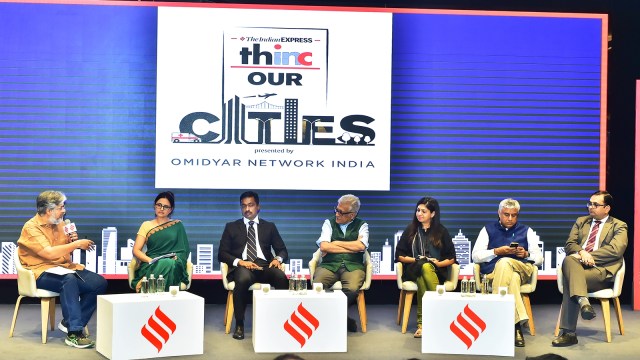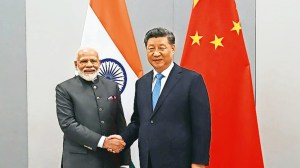IE THINC Second edition| Our cities: ‘Inequality, climate change to be big urban issues’
In this edition of IE-Thinc held in partnership with Omidyar Network India, experts talk about the changing definitions of what constitutes urban India, the growing traffic problem in Bengaluru, new ways to look at urban infrastructure and cluster-based planning of cities. The session was moderated by Associate Editor Udit Misra
 (From left) Udit Misra, Associate Editor, The Indian Express; Jaya Dhindaw, Executive Program Director, Sustainable Cities And Director, WRI India Ross Center; MN Anucheth, Joint Commissioner of Police, Traffic, Bengaluru; Naresh V Narasimhan, Managing Partner, Venkataramanan Associates; Nithya Ramesh, Director of Urban Design, JNNU Urban Space Foundation; MV Rajeev Gowda, Vice Chairperson, State Institute For The Transformation of Karnataka; Vivek Mittal, Executive Director, Deloitte India.
(From left) Udit Misra, Associate Editor, The Indian Express; Jaya Dhindaw, Executive Program Director, Sustainable Cities And Director, WRI India Ross Center; MN Anucheth, Joint Commissioner of Police, Traffic, Bengaluru; Naresh V Narasimhan, Managing Partner, Venkataramanan Associates; Nithya Ramesh, Director of Urban Design, JNNU Urban Space Foundation; MV Rajeev Gowda, Vice Chairperson, State Institute For The Transformation of Karnataka; Vivek Mittal, Executive Director, Deloitte India.On the traffic problem in Bengaluru
MN Anucheth: The vehicle population growth in Bengaluru is exponential, whereas the infrastructure to cope with that growth is linear. There is a lack of public transport and not many people use it. One estimate says about 28 per cent of Bengalureans use public transport, whereas, in other cities like Mumbai and Delhi, it’s much higher. At least we can reach 50 per cent of people using public transport. There are so many bottlenecks, our road dimensions are not correct and footpaths are inadequate or non-existent. We are not promoting mobility.
What is the fastest, cheapest and greenest mode of transport? Once you start thinking along those lines, the entire focus shifts. Historically, Bengaluru did not have a robust public transport system. BMTC carries about 40-50 lakh people a day. But the problem is that it has the same number of buses in 2024 as it did in 2000, which is 6,400. Public transport didn’t keep pace with the requirements of the day. Hence, there has been a tendency to go for private transport. Today, we have the moniker of having the largest number of private vehicles in India. We overtook Delhi in January.
On macro problems with urbanisation in India
Naresh V Narasimhan: All the infrastructure that the government can think of when they hear the word development or traffic mitigation is a flyover. The Indian political, administrative, lawmaking and policy systems have been hugely biased towards rural development. Only in the last 20 years have we seen some attention being paid to urban India.
Mumbai has a population of 2.4 crore. Bengaluru has a population of 1.2 crore, about half. But Mumbai has 36 lakh private vehicles while Bengaluru has 1.1 crore private vehicles. I think it’s the worst city in the world in terms of people-to-private vehicle ownership ratio, a vast majority of vehicles being two-wheelers. The cars in Bengaluru are about 15 lakh. This is a dystopian output from a cabal consisting of transport planners, consultants, politicians and the bureaucracy. Architects and designers have almost no role to play. I’m not saying architects and designers are the only people required. You probably need behavioural psychologists, economists and maybe poets to imagine beautiful things.
We have to completely abandon the fossil fuel era, models of the central business district (CBD) and living in the suburbs. These are all stupid Western ideas, which were predicated upon the availability of endless petrol, which is going to run out in 15 years. Before that, how are we going to move around? And no, electric vehicles (EV) are not the answer as you will just replace your petrol car with an EV. Traffic congestion won’t change.
We’ve consistently eaten the green belt all around the city. We should now make India’s outdoors as good as our indoors. Everybody who has access to resources lives in good quality indoors. But the outdoors — public spaces, the quality of our streets, the quality of our attitudes towards garbage — all that also needs to change.
On infrastructure-related issues in cities
Nithya Ramesh: Our focus is on large infrastructure projects, which are needed to grow our cities. However, there is not enough focus on urban design in most governments and bureaucracies. Urban planning and transport planning are, but urban design is often not recognised. The design of the outdoor space, the space as soon as you step out of your home — whether it’s your footpath, sidewalk, the neighbourhood park or the market where you shop — is not given adequate importance or funding. Cities grow and these places organically sprout because of people’s needs, but they’re not given priority. If we go to the West, one of the important places they’ll take you on the walking tour is their food market. Whereas our food markets are smelly and not nice places to go to.
A large problem is recognising the need for the design of our cities in between buildings and not just streets. The second is looking at smaller infrastructure to improve the quality of life in your neighbourhood. If I have to create a compact community, then I should be able to walk to everything I need in 15 minutes. My children should be able to go to football class without assistance and my aged parents should be able to walk to the market and buy their fruits. Economic growth and job opportunities need to be supported with a good quality of life which can come through planning and design. By design, it’s not just aesthetics, it’s also the engineering. Like a market has to be well-lit and ventilated. If it’s a fish market, it needs to have drainage so that the water they constantly use doesn’t overflow or smell.
On cluster-based planning of cities
Vivek Mittal: Cities are engines of economic growth and people come to cities in search of jobs and economic growth. As of now, all our cities are more focussed on spatial planning. Most cities do not even have the master plan or spatial plans.
But now cities should move around economic planning. This does not necessarily mean more industries. It means creating opportunities for everybody, an informal economy. We have to take all of that into consideration and say, where does my city go in the next 20-30 years? Then all the policies around my spatial growth and my infrastructure growth can result in long-term growth.
Each city has its own identity and the entire planning should move around that. For example, Bengaluru worked around the IT industry. The city has to move around that — what kind of labour will be here? What kind of jobs will be there? What kind of infrastructure will be there? What kind of support systems will be put in? I think NITI Aayog has already started a pilot project of making economic plans for four cities — Mumbai, Surat, Varanasi and Visakhapatnam. If you see Indian urbanisation, it is not only about tier-one and tier-two cities. We have around 100,000 cities which have one lakh population. For economic development, we have to follow a cluster approach. How do we give resources to the cluster approach? In most tier-two and tier-three cities, you’ll find that the local bodies have one or two technical officials, the rest are all like conservancy workers or class C and class D workers. If I don’t build their capacities, how will I make them future cities? The cluster-based approach is important for them.
On the changing definition of urban India
Jaya Dhindaw: Who do you think is responsible for cities, sustainability and progress? We don’t have clarity on that. We say India is 30 per cent urban and there’s rapid urbanisation. When you’re talking about 30 per cent urban, you’re only considering a certain administrative boundary. In the last 15 years, over 150 per cent of the growth in most Indian cities has happened outside the municipal boundaries from where you’re actually accounting for the urbanised population. When you’re talking about rapid urbanisation in terms of numbers, it’s not rapid because city centres within municipal boundaries are actually hollowing out; people are moving outside those boundaries. The growth is happening outside. According to the World Bank, the socio-economic built dimensions of the definition of urban for India is around 57 per cent. If you look at just built patterns, it’s over 60 per cent already. So the basic definition lies with what is urban. When it comes to traffic, water, sewage, any service, it won’t get provisioned for because you’re not recognising it as urban. In Bengaluru, when you’re building outside the peripheries, 85 per cent of the blue-green infrastructure is encroached by built-up because it’s not regularised. Therefore, it just gets built in the wrong areas.
Another issue is finance. In the last 10 years, the government has made that a central agenda. But climate action, environmental resource security and air quality are not electoral agenda for anybody still. Cities need something like $10 billion-$1 trillion in the next 10 years for infrastructure growth. Right now, we need four times that, when you account for the kind of urban patterns we have. The question is, who is responsible, where does this money come from and that leads to issues of inequity in cities. Inequality and soon enough, climate change, are going to be our biggest problems to solve. The problem has to do with the city’s ownership, the way you account for urbanisation.







